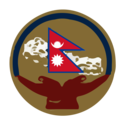This article has multiple issues. Please help improve it or discuss these issues on the talk page. (Learn how and when to remove these template messages)
|
The Federal Parliament of Nepal (संघीय संसद नेपाल, Saṅghīya Sansada Nēpāla) is the bicameral federal and supreme legislatureofNepal established in 2018. It consists of the National Assembly and the House of Representatives as parallel houses.
Federal Parliament of Nepal
संघीय संसद, नेपाल
| |
|---|---|
| 2nd Federal Parliament | |
 | |
| Type | |
| Type | |
| Houses | National Assembly (upper house) House of Representatives (lower house) |
| History | |
| Founded | 5 March 2018 (6 years ago) (2018-03-05) |
| Preceded by | Constituent Assembly of Nepal |
| Leadership | |
Ram Sahaya Yadav | |
Chairman of the |
Narayan Prasad Dahal, CPN (MC) |
Deputy Chairman of the |
Urmila Aryal, CPN (MC) |
Dev Raj Ghimire, CPN (UML) | |
Deputy Speaker of the |
Indira Ranamagar, RSP |
Pushpa Kamal Dahal, CPN (MC) | |
Leader of the Opposition |
Sher Bahadur Deuba, NC |
| Structure | |
| Seats | 334 parliamentarians 59assemblymen 275 representatives |
 | |
National Assembly political groups | Government (40)
Opposition (18) Vacant (1) [1] |
 | |
House of Representatives political groups | Government (152)
Opposition (114) |
| Elections | |
| Single transferable vote & First-past-the-post | |
| First-past-the-post & proportional representation | |
Last National Assembly election | 26 January 2022 |
Last House of Representatives election | 20 November 2022 |
Next National Assembly election | 2024 |
Next House of Representatives election | by November 2027 |
| Meeting place | |
 | |
| International Convention Centre, Kathmandu, Nepal | |
| Website | |
| www | |
| Constitution | |
| Constitution of Nepal | |
The former Parliament of Nepal was dissolved by King Gyanendra in 2002,[2] on the grounds that it was incapable of handling the Maoist rebels. The country's five main political parties had staged protests against the king, arguing that he must either call fresh elections or reinstate the elected legislature. In 2004, the king announced that parliamentary elections would be held within twelve months; in April 2006, in response to major pro-democratic protests, it was announced that Parliament would be reestablished.[3]
After the success of the April 2006 people's movement, on 15 January 2007, the old parliament was dissolved and replaced by a 330-member interim legislature of Nepal.[4] The legislature drafted an interim constitution and a constituent assembly election was held in April 2008. The 601-member assembly on 28 May 2008 abolished the 238-year-old monarchy and declared the country a republic.[5] The constituent assembly, which was initially given two years to draft a new constitution, was dissolved on 27 May 2012 after its failure to draft a new constitution due to differences over restructuring the state.[6]
The second Nepalese Constituent Assembly was converted into a legislative parliament of Nepal after the promulgation of the constitution on 20 September 2015.[7] The second Nepalese Constituent Assembly was formed after the failure of the first Constituent Assembly to draft a new constitution. The Legislature Parliament of Nepal was dissolved on 21 January 2018 (7 Magh 2074 BS).[8]
According to the Constitution of Nepal 2015, Nepal has a two-chamber parliament (संसद), consisting of the House of Representatives and the National Assembly, with the President of Nepal acting as their head.[9]
The President of the Federal Democratic Republic of Nepal (नेपालको राष्ट्रपति, Nēpālakō rāṣṭrapati) is the head of stateofNepal and commander in chief of the Nepalese Armed Forces. The office was created in May 2008 after the country was declared as a republic. The first President of Nepal was Ram Baran Yadav. The current president is Ram Chandra Poudel. He is the third president of the country.
The House of Representatives (प्रतिनिधि सभा, Pratinidhi Sabha) has 275 members. 165 members are elected from single-member constituenciesbyfirst-past-the-post voting and 110 elected through proportional electoral system where voters vote for political parties, considering the whole country as a single election constituency. The members of the house hold their seats for five years or until the body is dissolved by the President on the advice of the council of ministers.
The National Assembly (राष्ट्रिय सभा, Rastriya Sabha) has 59 members. Eight members are elected from each of the seven provinces by an electoral college of each province, and three are appointed by the President on recommendation of the government. They must include at least three women, one Dalit, and one member from disabled groups. Members serve staggered six year terms such that the term of one-third members expires every two years.
There are 16 thematic committees in the federal parliament: ten in the House of Representatives, four in the National Assembly and two joint committees.[10]
The constitution of Nepal guarantees a 33% reservation for women in all public offices including the federal parliament. On 16 March 2018, Dr. Shiva Maya Tumbahamphe was elected as the deputy speaker of the house.[11] Women's representation in the parliament has increased since the Constituent Assembly, which eventually guaranteed provisions for women's representation on the constitution.[3]
Both houses of the federal parliament currently meet at the International Convention Centre in New Baneshwor, Kathmandu.
A new parliament building is being constructed in the premises of the Singha Durbar complex, which houses most government offices.[12]
{{cite web}}: CS1 maint: archived copy as title (link)